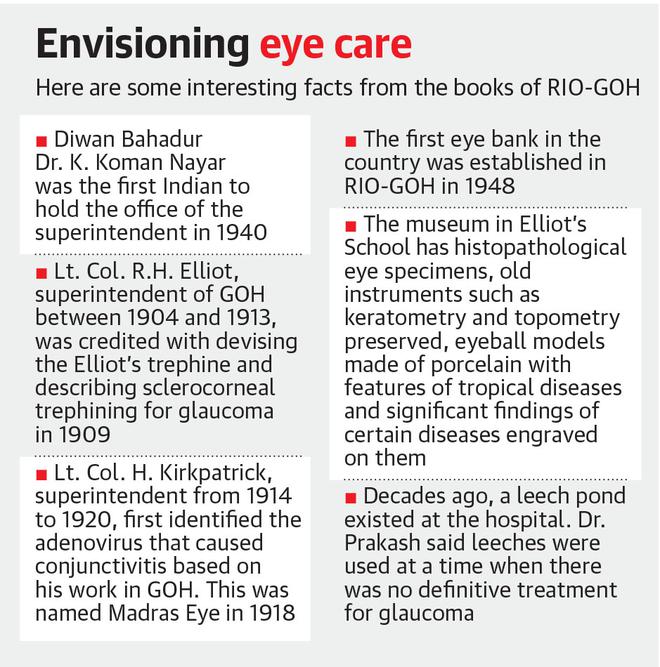Red-brick buildings are more than just brick and mortar. They are like a storehouse of stories.
On a partially busy Rukmani Lakshmipathy Salai in Egmore, Chennai, stands one such institution where the past and present co-exist: the 203-year-old Regional Institute of Ophthalmology and Government Government Ophthalmic Hospital (RIO-GOH), which is oldest ophthalmic institute in Southeast Asia. The institute was the second oldest eye hospital in the world, after Moorfields Eye Hospital in London, which was established in 1809.
The prevalence of eye diseases among soldiers led to the establishment of ‘Madras Eye Infirmary’ in July 1819 at Royapettah. The hospital moved to the present location in 1884, and was re-named the Government Ophthalmic Hospital in 1888.
While the old block is located on the eastern side, a new building of ‘Shawfield’ came up on the western side later. Initially, the hospital comprised three main isolated blocks, an outpatient dispensary, European and Indian kitchen and a residence inaugurated on March 31, 1887. All these blocks were connected by six corridors a year later, according to records in the hospital.
In fact, the Lady Lawley Block, built and occupied in 1911, is still in use for in-patients and houses an operation theatre.
“The hospital has seen the evolution of ophthalmology from ancient methods to the most modern techniques of treatment. It has trained thousands of ophthalmologists over the years. Scores of ophthalmic chiefs across the country have had their grooming here,” pointed out M.V. S. Prakash, Director, RIO-GOH.
Today, 600-800 patients walk in for outpatient services at RIO-GOH every day. The hospital has a bed strength of 478. It offers services in six sub-specialities of ophthalmology — cornea, orbit and oculoplasty, squint (paediatric ophthalmology and neuro ophthalmology), retina, glaucoma and uvea.
RIO-GOH receives patients from various parts of Tamil Nadu and also Andhra Pradesh and Puducherry, Dr. Prakash said, adding that the hospital runs a round-the-clock trauma center for treating eye injuries.
Patient flow has been steadily rising after a slowdown during the COVID-19 pandemic. “In the pre-COVID times, we had 60,000 to 70,000 admissions per year. During the pandemic, it dropped to 35,000, and is picking up now,” he said.
The institute has been training ophthalmologists as well. ‘The Elliot’s School of Ophthalmology’, named after Lt. Col. R.H. Elliot, superintendent of the hospital from 1904 to 1913, was opened in 1920. The institute has 30 MS ophthalmology seats, besides 30 diploma seats and 20 B.Sc. optometry seats. “Under the National Programme for Control of Blindness, we get doctors from several States to get trained in various sub-specialities here,” Dr. Prakash added.
One of the key highlights of RIO-GOH is the museum in the Elliot School, a treasure trove of ophthalmic records, specimens and instruments. The museum has handwritten case sheets, hand- drawn portraits of patients with various eye disorders such as keloid and dermoid, eyeball models, and ophthalmic instruments. An ophthalmic cryomachine used in the treatment of a variety of benign and malignant tumours using extreme cold to freeze and destroy abnormal tissue is among the instruments on display.
“Hand-written manuscripts and case sheets written by British ophthalmologists that are 100 years old are well-preserved by professional curators. At a time when photography was not available, artistes were engaged to sketch patients with various eye diseases,” the Director pointed out.

Renovation of the museum began in line with the bicentenary celebrations in 2019, and is in progress.
The country’s first eye bank was established in the hospital in 1948 by R.E.S. Muthiah, who became the superintendent a year earlier. The first corneal transplant was performed in the same year after he returned from a study tour in the U.S.
The institute is now eyeing expansion. A seven-storey block is being constructed as the present outpatient building was overcrowded and lacked adequate space. “The new facility is a spacious one. Once this is ready, all the speciality departments, located in the present outpatient building will be shifted... This block will also have additional operation theatres and wards. This will pave the way for expansion in the future,” Dr. Prakash said.







